IDEXX SDMA
SDMA Case Study: Bess
SDMA helps identify advanced chronic kidney disease in an older cat

Background information
Name: Bess
Age: 15 years
Breed: Domestic shorthair
Gender: Female
Presenting reason
Bess was due for a routine annual wellness examination.
History
The owner reported that Bess was slowing down as she got older and was not eating as much as she used to. Her owner had not noticed any changes in drinking or urinating, though she is part of a multiple-cat household.
Physical examination
Bess showed some moderate periodontal disease, and other examination parameters were within normal limits. There was thinning of her muscle mass over her back, as commonly seen with older patients.
Diagnostic plan
Complete blood count (CBC); chemistry panel, including the IDEXX SDMA Test and electrolytes; complete urinalysis; and total T4 were recommended. For Bess and patients her age with similar pet-owner observations, these tests are appropriate to build a good clinical picture alongside the physical examination.
Diagnostic review
Bess showed an increased SDMA* and concurrent decrease in urine-concentrating ability with a urine specific gravity of 1.014. Her CBC, other chemistry panel indicators, and total T4 were otherwise within normal limits.
Possible next steps
-
The increased SDMA signalled the need to investigate kidney health further. The appropriate next step is a complete urinalysis, which was performed already. The low urine specific gravity was further evidence of kidney health compromise.
-
Diagnostic imaging can be of value to further evaluate the kidneys, to confirm kidney disease and to help determine an underlying cause (e.g., evidence of infection or stone), and it should be considered in patients showing evidence of kidney disease.
- Blood pressure should be further evaluated in patients with kidney disease.
Follow-up action
- Follow-up diagnostics 2 weeks later included radiographs, blood pressure measurement, and follow-up CBC, chemistry and complete urinalysis along with a urine protein: creatinine (UPC) ratio.
- Results: Radiographs showed no evidence of stones, with kidneys smaller than normal size. The only abnormality on the laboratory results was an increased SDMA of 25 μg/dL, and urine specific gravity remained low at 1.016. She was normotensive with a blood pressure of 145 mm Hg. Her UPC ratio was normal at 0.1.
Diagnosis
Following the International Renal Interest Society (IRIS) Chronic Kidney Disease (CKD) Staging Guidelines, these findings showed that Bess had IRIS CKD Stage 2 disease, substaged as normotensive and nonproteinuric. However, given that Bess’s SDMA result was 25 μg/dL, per the IRIS CKD Staging Guidelines, creatinine had underestimated the degree of Bess’s kidney dysfunction. Treatment recommendations for IRIS CKD Stage 3 disease should be considered.
Patient reports
Chemistry
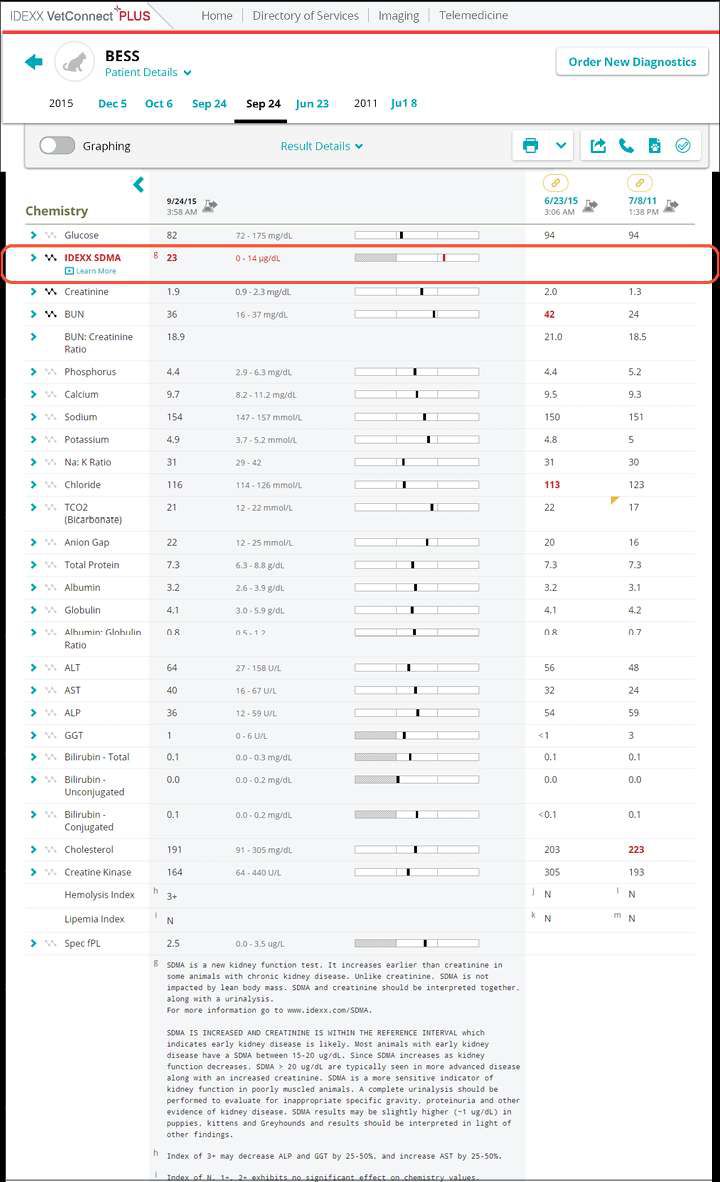
Total T4
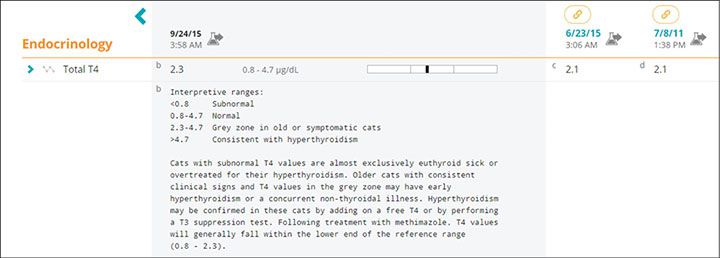
Haematology
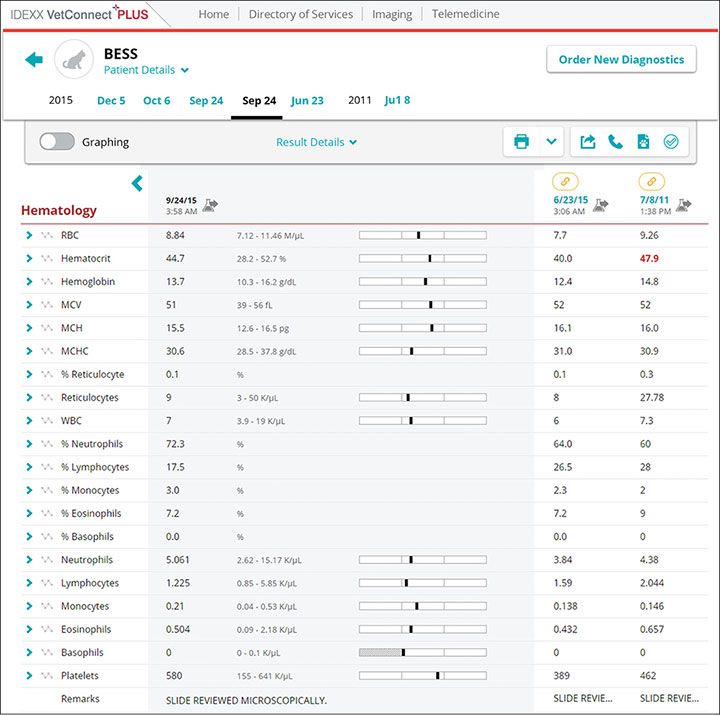
Urinalysis
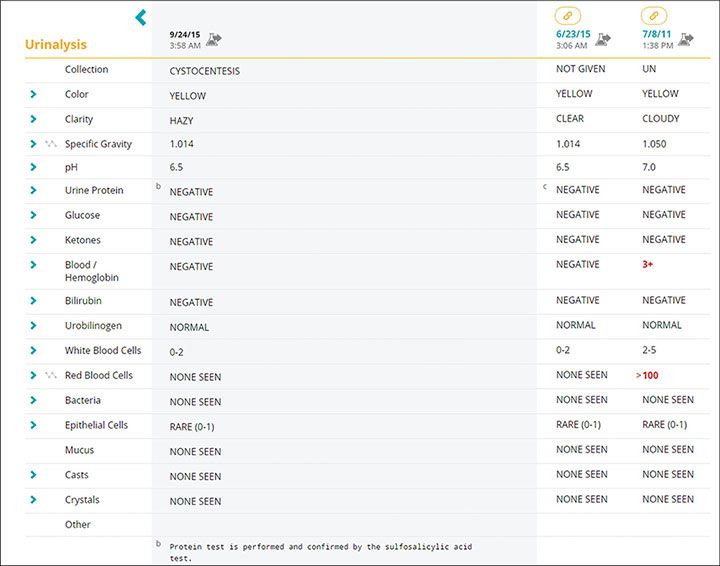
IRIS CKD staging guidelines
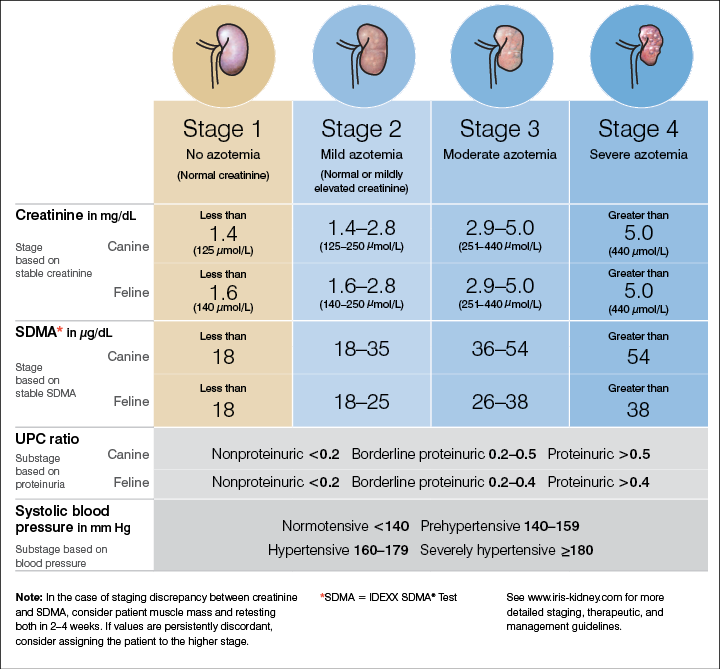
Discussion
SDMA is more reliable than creatinine in assessing kidney health and detection of disease.1-5
Cases like Bess’s are common in our practices – an older patient experiencing muscle loss with age and decreased activity. Creatinine is a breakdown product of muscle, and as muscle mass decreases it will impact creatinine levels on chemistry evaluations. SDMA is not influenced by muscle mass and as such is more reliable in detecting kidney disease.4,5
IRIS has recognised the medical importance of SDMA and has included it in its guidelines for diagnosing, staging and treating CKD.
*Symmetric dimethylarginine.
References
- Nabity MB, Lees GE, Boggess M, et al. Symmetric dimethylarginine assay validation, stability and evaluation as a marker for early detection of chronic kidney disease in dogs. J Vet Intern Med. 2015;29(4):1036-1044.
- Hall JA, Yerramilli M, Obare E, Yerramilli M, Jewell DE. Comparison of serum concentrations of symmetric dimethylarginine and creatinine as kidney function biomarkers in cats with chronic kidney disease. J Vet Intern Med. 2014;28(6):1676-1683.
- Hall JA, Yerramilli M, Obare E, Yerramilli M, Almes K, Jewell DE. Serum concentrations of symmetric dimethylarginine and creatinine in dogs with naturally occurring chronic kidney disease. J Vet Intern Med. 2016;30(3):794-802.
- Hall JA, Yerramilli M, Obare E, Yerramilli M, Yu S, Jewell DE. Comparison of serum concentrations of symmetric dimethylarginine and creatinine as kidney function biomarkers in healthy geriatric cats fed reduced-protein foods enriched with fish oil, L-carnitine and medium-chain triglycerides. Vet J. 2014;202(3):588-596.
- Hall JA, Yerramilli M, Obare E, Yerramilli M, Melendez LD, Jewell DE. Relationship between lean body mass and serum renal biomarkers in healthy dogs. J Vet Intern Med. 2015;29(3):808-814.